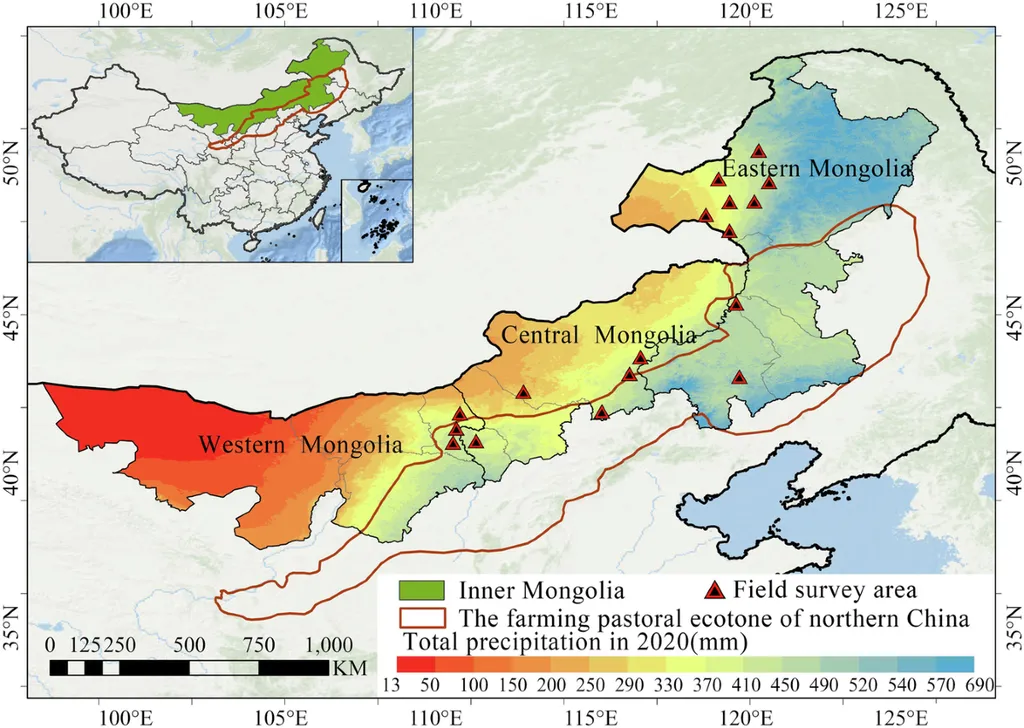In the vast, ecologically fragile borderlands stretching across China, Mongolia, and Russia, a groundbreaking study has emerged that could reshape how we monitor and manage grassland ecosystems. Led by Jiani Ma from the College of Geographical Sciences at Shanxi Normal University, the research, published in the journal *Remote Sensing* (translated from Chinese as “Remote Sensing”), offers a novel approach to estimating and analyzing aboveground biomass (AGB), a critical indicator for carbon sequestration and ecosystem health.
The study introduces an advanced AGB estimation model that combines SHAP-based feature selection with a particle swarm optimization-enhanced random forest model (RF_PSO). This method has achieved unprecedented accuracy, with an R² value of 0.87 and an RMSE of 45.8 g/m², outperforming other existing models. “The integration of SHAP for feature selection and RF_PSO for model enhancement has significantly improved the precision and spatiotemporal representation of our AGB estimates,” Ma explained.
The research focuses on the China–Mongolia–Russia (CMR) border area, a region characterized by its ecological fragility and transboundary nature. By analyzing data from 2000 to 2020, the study reveals that 72.13% of the area has seen improvements in AGB, primarily in the eastern and central parts of Mongolia and northern China. However, 27.39% of the region has experienced degradation, concentrated in northern China and central Mongolia. Only 0.48% of the area remains stable, scattered across parts of Russia.
One of the most compelling aspects of the study is its identification of four distinct change patterns: Fluctuating Low, Stable Low, Fluctuating High, and Stable High. These patterns highlight significant shifts in AGB occurring in 2007, 2012, and 2014. “Understanding these patterns is crucial for developing targeted interventions and policies to manage and protect these fragile ecosystems,” Ma noted.
The projections from this research are equally insightful. The study suggests that 80% of the region may maintain its current trends, 13% could reverse their current trajectory, and 7% remain uncertain. These findings have profound implications for the energy sector, particularly in carbon sequestration and ecosystem management. Accurate AGB estimation is essential for assessing carbon stocks and developing strategies to mitigate climate change.
The commercial impacts of this research are substantial. For the energy sector, precise AGB data can inform decisions related to carbon credits, reforestation projects, and sustainable land management. “This research provides a robust tool for high-precision AGB estimation and supports dynamic monitoring in the CMR border area,” Ma stated. The ability to predict and manage ecosystem changes can lead to more effective carbon sequestration strategies, benefiting both the environment and the energy industry.
As we look to the future, this study offers a blueprint for high-precision AGB estimation and dynamic monitoring in ecologically fragile regions. The methods and insights gained from this research can be applied to other transboundary areas, supporting global efforts to combat climate change and promote sustainable development. The work of Jiani Ma and her team represents a significant advancement in the field, paving the way for more accurate and effective ecosystem management.

